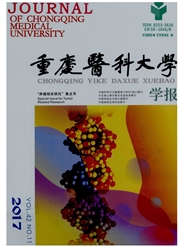

 中文摘要:
中文摘要:
目的:探讨滋养细胞体外缺氧不同处理方法模拟子痫前期模型的优化研究。方法:HTR8/SVneo滋养细胞分别在1%O2(缺氧环境)和21%O2(常氧环境)培养箱中培养1 h(记为H1、N1)或2 h(记为H2、N2),缺氧1 h后复氧1 h(记为H1R1)和缺氧2 h后复氧2 h(记为H2R2),H1R1后再缺氧1 h(记为H1R1H1),H2R2后再缺氧2 h(记为H2R2H2),H1R12个循环(记为H1R1H1R1)和H2R22个循环(记为H2R2H2R2),缺氧2 h后复氧6 h(记为H2R6),持续缺氧24 h,以及持续常氧4 h(记为N4)、8 h(记为N8)和24 h(记为Normoxia),然后提取蛋白以Western blot检测腺苷酸活化蛋白激酶(AMP-activated protein kinase,AMPK)磷酸化水平,以验证各组处理对于诱导滋养细胞能量应激的效果;HTR8/SVneo滋养细胞在常氧或者缺氧环境培养24 h后经气相质谱技术(gas chromatography mass spectrum,GS-MS)进行细胞代谢组学分析,以验证AMPK磷酸化水平上调是否与滋养细胞代谢组变化具有一致性。结果:缺氧组AMPK的活性(1.615±0.111)明显高于常氧组(1.000±0.107)和缺氧复氧组(1.277±0.113);缺氧时显著增加的代谢物有4-甲基-2-戊酮酸(log22.597为1.377)、水合乙醛酸(log22.483为1.312)、组氨酸(log21.188为0.248)、苯丙氨酸(log21.262为0.335)、缬氨酸(log21.518为0.602)、正亮氨酸(log21.519为0.603)、乙酰丝氨酸(log21.691为0.758)、丝氨酸(log21.783为0.834)、半胱氨酸(log21.851为0.889)、蛋氨酸(log22.072为1.051)、鸟氨酸(log22.251为1.170)等;而棕榈反油酸(log20.127为-2.983)、11,14,17-廿碳三烯酸(log20.334为-1.583)、二十四单烯酸(log20.600为-0.738)、共轭亚油酸(log20.680为-0.557)、顺式十八碳烯酸(log20.711为-0.492)、9-十七碳烯酸(log20.782为-0.355)、二十二碳六烯酸(log20.829为-0.271)、二十碳五烯酸(log20.841为-0.250)、芥酸(log20.844为-0.244)、二十二碳五?
 英文摘要:
英文摘要:
Objective:To investigate the optimal in vitro hypoxia cell mode for preeclampsia study. Methods:Western blot was used to determine the phosphorylation of AMPK after HTR8/SVneo trophoblast cell being treated with 1% O2(hypoxia condition) or21% O2(normoxia condition)for various duration. GC-MS was used for assessing metabolome of HTR8/SVneo trophoblast cell after being incubated in normoxia or hypoxia environment,to validate the synchronous alteration in AMPK phosphorylation and metabolome. Results:The activity of AMPK was higher in hypoxia group(1.615 ±0.111) than in normoxia group(1.000 ±0.107) and hypoxia/reoxygenation group(1.277 ±0.113). The in-creased metabonomics of the HTR8/SVneo trophoblast cell induced by hypoxia were 4-methyl-2-oxopentanoic acid(log22.597 =1.377),glyoxylic acid(log22.483=1.312),histidine(log21.188 =0.248),phenylalanine(log21.262 =0.335),valine(log21.518 =0.602),norleucine(log21.519=0.603),O-aacetylserine(log21.691=0.758),serine(log21.783=0.834),cysteine(log21.851=0.889),methionine(log22. 072 = 1. 051),ornithine(log22. 251 = 1. 170). But palmitelaidic acid(log20. 127 =-2. 983),11,14,17-eicosatrienoic acid(log20.334=-1.583),nervonic acid(log20.600=-0.738),conjugated linoleic acid(log20.680=-0.557),cis-vaccenic acid(log20.711=-0.492),9-heptadecenoic acid(log20.782=-0.355),DHA(log20.829=-0.271),EPA(log2 0.841=-0.250),erucic acid(log20.844=-0.244),DPA(log20.898=-0.156),citric acid(log20.279=-1.842),malic acid(log20.208=-2.264),succinic acid(log20.254=-1.980),cis-aconitic acid(log20.260=-1.946),beta-citryl-L-glutamic acid(log20.093=-3.430),beta-alanine(log20.139=-2.851),cystathionine(log20.267 =-1.904),cis-4-hydroxyproline(log20.500 =-1.000) were decreased in hypoxia group. The metabolic pathway analysis shown the nucleotide metabolism [log2(1.811、1.149)=0.857,0.201],the energy metabolism[log2(1.510、1.173、1.149)=0.595,0.230,0.201],the me
 同期刊论文项目
同期刊论文项目
 同项目期刊论文
同项目期刊论文
 期刊信息
期刊信息
